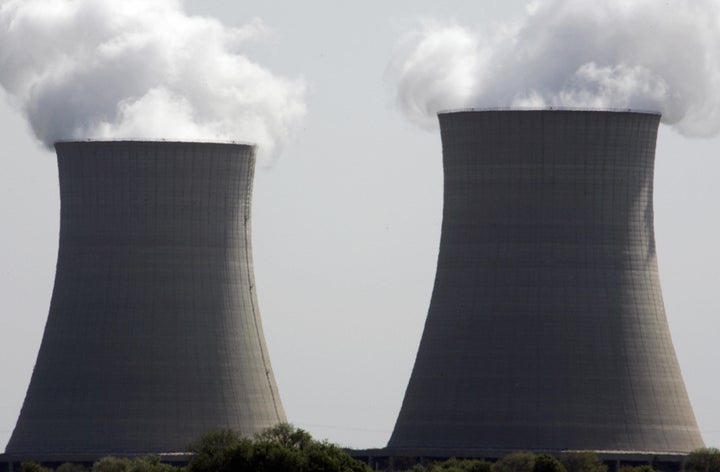
In the lead-up to the 2016 election, the most formidable candidates vying to serve as our next president have largely avoided the topic of nuclear power. Indeed, they have encountered little pressure to address it even as the Paris climate talks open, with none of the Republican or Democratic debates so far including a single, specific question on nuclear energy. Only one Republican candidate, Chris Christie, and one former Democratic candidate, Jim Webb, broached the subject during the past debates. Christie strongly endorsed nuclear energy, arguing that if we want to mitigate climate change, "nuclear needs to be back on the table in a significant way." In a subsequent forum across the aisle, Webb essentially agreed.
Bernie Sanders appears to be the only candidate to reject expressly an increased reliance on nuclear power. Back in May, Sanders indicated that he does not support building more nuclear plants "when we do not know how we get rid of the toxic waste from the ones that already exist." Sanders, however, since then has side-stepped the issue. Hillary Clinton and Martin O'Malley have also been cautious and evasive, but clues from their climate proposals and past positions indicate support for nuclear energy in combination with renewable sources. Clinton's climate plan seems to maintain nuclear at current levels, while O'Malley historically has expressed strong support for innovative nuclear technology. Jeb Bush has expressed robust support of nuclear power, emphasizing access to new technologies that include advanced nuclear power designs.
President Dwight D. Eisenhower epitomized the embrace of nuclear technology in his "Atoms for Peace" speech to the United Nations in 1953. After that, support for nuclear power dwindled on the left, as deep fears of radiation, contamination, proliferation, and nuclear terrorism developed over the ensuing decades. What is emerging now with the growing awareness of climate change suggests the possibility of a return to the bipartisan consensus in the early 1950s.
Republicans for the most part have never wavered in their support of nuclear power. The sea change is on the left, where a new consciousness has arisen among a number of influential environmental activists. These activists argue that nuclear power must play a significant part in the energy mix if we are to have any chance of stemming the consequences of global warming.
The most influential climate scientist urging the acceptance of nuclear power is James Hansen of Columbia University's Earth Institute. Hansen is not alone. Other prominent advocates have included renowned economist Jeffrey Sachs; former Greenpeace leader Patrick Moore; Whole Earth Catalog editor Stewart Brand; and billionaire Bill Gates. A 2013 Sundance documentary, Pandora's Promise, tracks the conversion of featured activists from anti- to pro-nuclear positions, resigned to believe that nuclear power provides the only realistic approach to curbing climate change.
Supporters of nuclear power emphasize its ability to meet demands with reliable, baseload energy, while leaving no carbon footprint from energy generation. Advocates also highlight research into improving nuclear waste management. Bill Gates has invested in TerraPower's traveling wave reactor concept, a type of waste recycling that utilizes depleted uranium as fuel. Others have suggested converting high level nuclear waste into glass, or launching it into space.
Those who remain cautious about any reliance on nuclear energy point out that following cancellation of the Yucca Mountain project, there is no safe and permanent repository for roughly 70,000 metric tons of U.S.-produced spent nuclear fuel already in existence, nor the additional 2,200 metric tons of spent fuel produced in the U.S. annually. This high level radioactive waste may remain dangerous for hundreds of thousands of years. Meanwhile, the very real threat of nuclear terrorism persists, along with proliferation risks. Finally, concerns about plant safety weigh heavily after historic accidents at Three Mile Island, Chernobyl, and most recently, the tragic disaster at Fukushima Daiichi.
The most critical question, in determining whether to promote nuclear energy, is whether there is a viable alternative. Increasing nuclear capacity is not necessary if a transition to renewables can be achieved before emissions cause a catastrophic rise in global temperatures. For Hansen, the answer is obvious. The idea that clean energy can scale up fast enough to replace fossil fuels is so naïve, he says, that we might as well believe in the Easter bunny and the tooth fairy.
But in reality, the question of how fast renewables can scale up is far from settled. An analysis by Greenpeace outlines a pathway to 100 percent global renewable energy by 2050, and engineers from Stanford University and colleagues similarly outlined a state-by-state roadmap to reach 100 percent renewables by the same year. Recent progress yields encouraging signs. Between 2007 and 2014, wind, solar, biomass, and other non-hydroelectric renewables together nearly tripled their contributions to the U.S. electricity supply. Including hydroelectric, renewables accounted for 13 percent of energy consumed in the electric power sector in 2014. By the end of 2014, renewables comprised roughly 27 percent of the world's generating capacity.
Renewable energy provides the exclusive power source for three U.S. cities: Burlington, Vermont; Greensburg, Kansas; and Aspen, Colorado. States like Maine, California, Vermont, and Hawaii, have led with strong regulatory targets known as renewable portfolio standards (RPSs); New York adopted an ambitious RPS as well. The business sector likewise is prioritizing energy transition, with many corporations committed to 100 percent renewable power within the coming decades. Roughly 40 companies have joined the global RE100 initiative, including powerhouses like Nike, Walmart, Goldman Sachs, Johnson & Johnson, and Procter & Gamble.
Moreover, these strides are occurring in spite of entrenched support for non-renewable energy sources. In 2013, fossil fuels received roughly $550 billion in global subsidies, artificially lowering consumption prices and making it harder for clean energy to compete. According to the International Energy Agency, renewable subsidies stood at less than one quarter that amount for the same year. Nuclear power likewise receives substantial public subsidies, as the Union of Concerned Scientists reported in 2011. And the Price Anderson Act, originally passed in 1957, requires the U.S. government (i.e., taxpayers) to partially indemnify nuclear providers for damages from nuclear accidents.
Tom Steyer, the billionaire environmentalist and liberal donor, has called on the Democratic nomination seekers to provide additional details about their climate and energy plans. Yet any candidate who takes a stand on nuclear power will enter a daunting landscape. Not only will this require intricate analysis of the Clean Power Plan's provisions and other complex policy questions, but candidates also must navigate a tricky path through the energy sector's political war chests. These include considerable funds flowing from the nuclear industry itself. One company estimates that the Nuclear Energy Institute (NEI) budgeted $13 million in 2011 to coordinate an industry response to the Fukushima disaster. And in 2013 and 2014, the top five U.S. nuclear energy companies and NEI spent a combined total of $60.4 million to lobby Congress and federal agencies.
Despite its legitimate urgency, global warming should not trigger a race to build more nuclear power plants. Rather, an upsurge in political momentum is needed to support the rapid rise of renewable energy. Democratic and Republican presidential contenders have failed to clarify their own ideas about the future of nuclear power within our energy mix, and the time is ripe for a meaningful public conversation. Regardless of affiliations and preconceptions, the question of whether to rely on nuclear power in a warming world is too important to ignore.
